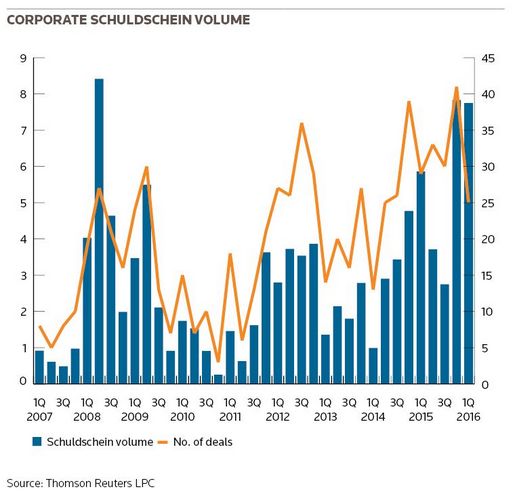After last year’s stellar level of issuance, the Schuldschein market remains highly liquid as strong investor demand sees high volumes maintained and an increase in the number of larger deals.
Corporate Schuldschein volume in the first quarter reached €7.7bn, the third highest quarterly volume ever, according to Thomson Reuters LPC data. The total is already well on its way to top the €20bn seen in 2015.
“The acceptance of the product by both issuers and investors has increased, with an increase in clients using Schuldschein to take out M&A debt, while there has been a window of opportunity where often even rated issuers can get more attractive pricing compared to other capital markets,” said Raoul Hessling, Schuldschein specialist at BNP Paribas in Frankfurt.
For borrowers, Schuldschein also compares favourably compared with other debt instruments.
“The main reason for the strong volumes we’re seeing is that pricing, relative to other capital markets, remains very attractive to borrowers,” said Richard Waddington, head of Schuldschein and loan sales at Commerzbank, Corporates & Markets.
The perception of the Schuldschein market has changed from an old-style domestic instrument into a truly international product attracting both international issuers and investors.
While the French Euro Private Placement (Euro PP) remains an almost exclusively domestic product, the Schuldschein has expanded across geographies, offers access to relatively deep pools of liquidity and is more akin to the US private placement market.
International investors have been attracted to the Schuldschein product because of the optionality if offers in terms of maturities.
“One aspect that it is increasingly important to take account of is the flexibility this product offers to investors when it comes to tranching. A multi-tranche SSD offers an arbitrage between pricing and maturity that a corporate bond does not,” said Reinhard Haas, head of DCM loans at Commerzbank.
Larger and greener
In addition to keeping pricing low, the influx of international investors into the market has also seen an increase in the number of bigger deals.
“This used to be a solely domestic market, mainly funded by the German savings banks, now investors from outside Germany have come in, this includes some large commercial banks, and they are providing much bigger clip sizes,” Waddington said.
In 2014, there was only one Schuldschein of over €500m, in 2015 there were seven, including a record €2.2bn deal for automotive supplier ZF Friedrichshafen. There have been six already in 2016.
“For a transaction of over €500m, you need a good mix of domestic and international investors,” Hessling said.
For example, in February, independent telecoms provider Freenet placed a €560m Schuldschein, an increase from the launch amount of €300m. The issue comprised five-year, seven-year and 10-year tranches. BayernLB, Commerzbank, LBBW and UniCredit arranged the financing, which was placed with a widely spread group of institutional investors in Germany and abroad.
A jumbo Schuldschein totalling more than €1.1bn for sports car maker Porsche was placed at the beginning of March 2016 – increased from a launch amount of just €200m. The financing, which was arranged by LBBW and UniCredit Bank, was split between three-year, five-year and seven-year maturities.
The financing was placed with over 150 institutional investors, including banks, pension funds and insurance companies. Non-German investors contributed 45% of the total facilities.
Another major factor in the recent growth of the Schuldschein market has been companies using the product to finance or refinance acquisitions, so much so that it is regularly discussed in early stages of acquisitions, bankers said.
In January, HeidelbergCement tapped the market for a €625m seven-year Schuldschein via LBBW, Helaba and Raiffeisen Bank International. The financing was used to reduce a bridge loan that had been arranged in 2015 to back the acquisition of Italcementi and help pre-fund the acquisition initial stake purchase.
Wind turbine maker Nordex placed the first ever “green” Schuldschein in late March, raising €550m from investors. The notes will be used to finance the acquisition of Acciona Windpower on a medium-to-long-term basis.
The financing, which carries certification allowing Environmental, Social and corporate Governance (ESG) investors to participate, was arranged by BayernLB, BNP Paribas, Commerzbank, HSBC and UniCredit.
The placement was issued in tranches of three, five and seven years with fixed and variable coupons. ESG investors made up around 25% of commitments, with just under half the financing being provided by German accounts, particularly savings and cooperative banks. Over 50% of the commitments came from international investors.
To see the digital version of this special report, please click here
To purchase printed copies or a PDF of this report, please email gloria.balbastro@thomsonreuters.com



